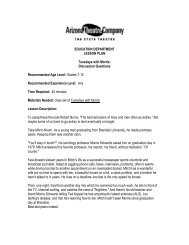CHARACTERS SYNOPSIS - Arizona Theatre Company
CHARACTERS SYNOPSIS - Arizona Theatre Company
CHARACTERS SYNOPSIS - Arizona Theatre Company
Create successful ePaper yourself
Turn your PDF publications into a flip-book with our unique Google optimized e-Paper software.
LIBRETTIST<br />
Lorenzo Da Ponte wrote the libretto of The Marriage of Figaro, meaning he wrote the<br />
words to Mozart’s music. Da Ponte was born on March 10, 1749 in the Jewish ghetto of Ceneda,<br />
Italy. Da Ponte studied at seminary to become a priest. This is<br />
where he was first introduced to Italian poets, starting his lifelong<br />
love of this genre. Though ordained as a priest at age 24, the<br />
priest lifestyle did not fit Da Ponte, as he was infamous for<br />
gambling and affairs with married women. Da Ponte moved from<br />
Venice to Vienna, the true cultural center at that time. The<br />
Emperor of Vienna was known for his tolerance of Jewish people,<br />
something the rest of Europe did not share, and so Da Ponte felt<br />
satisfied knowing that his origins would not be held against him.<br />
In 1783, Da Ponte was appointed theatre-poet to the Court Opera<br />
in Vienna, which was then devoted to the production of Italian comic opera. It was there that he<br />
met Mozart, and the three collaborated on Le Nozze di Figaro, Cosi fan tutte, and Don Giovanni.<br />
In 1792, Da Ponte moved to London to work with an Italian opera company. It was there<br />
he met Nancy Grahl, whom he dated the rest of his life. In 1805, he and Nancy departed for the<br />
United States, where Da Ponte became a merchant, a bookseller, and a professor of Italian at<br />
Columbia University. Much of his time in the United States was devoted to promoting Italian<br />
opera.<br />
OPERA DEFINITIONS<br />
Aria – An aria is a solo where one character expresses his or her emotional state for several<br />
minutes. While the words to an aria are important, they are sparse and the singer usually repeats<br />
words multiple times.<br />
Aside – A comment from an actor to the audience that the other characters cannot hear.<br />
Bel Canto – “beautiful singing” in Italian. In opera, it is an Italian style of singing emphasizing tone,<br />
phrasing, coloratura passages, and technique.<br />
Cabaletta – Second, faster part of a two-part aria.<br />
Cadenza – a passage of singing, often at the end of an aria, that shows off the singer’s vocal abilities.<br />
Cavatina – The opening, slow section of a two-part aria.<br />
Coloratura – elaborate ornamentation of music written for a singer using many fast notes and trills


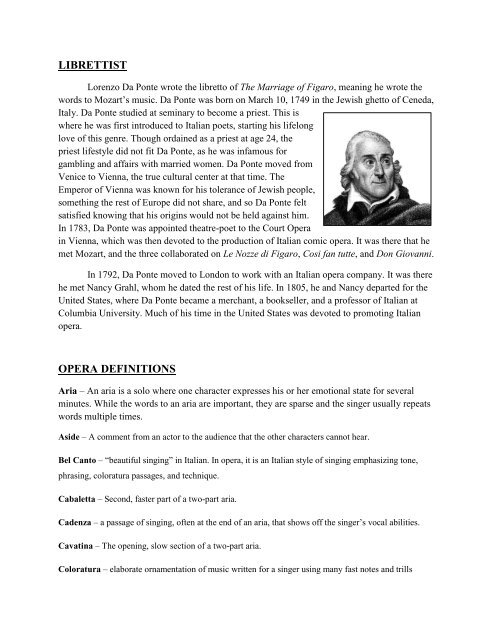
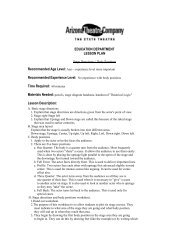



![Play Guide [356k PDF] - Arizona Theatre Company](https://img.yumpu.com/46218320/1/190x245/play-guide-356k-pdf-arizona-theatre-company.jpg?quality=85)
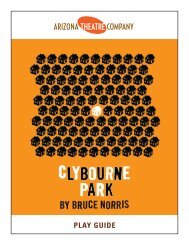
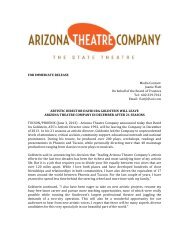
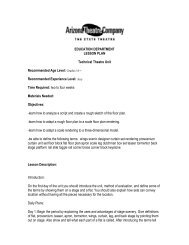
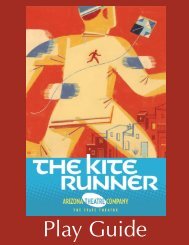
![[title of show] Arizona Theatre Company Play Guide 1](https://img.yumpu.com/24482689/1/190x245/title-of-show-arizona-theatre-company-play-guide-1.jpg?quality=85)
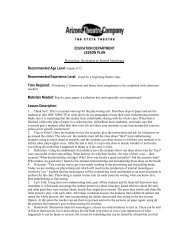
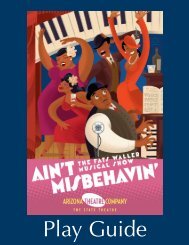
![Play Guide [1.2MB PDF] - Arizona Theatre Company](https://img.yumpu.com/11952176/1/190x245/play-guide-12mb-pdf-arizona-theatre-company.jpg?quality=85)
